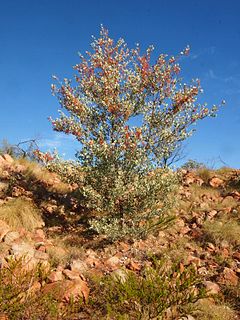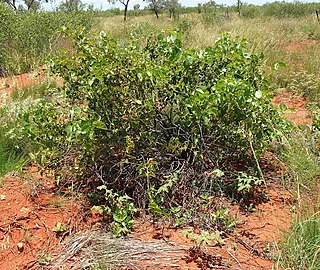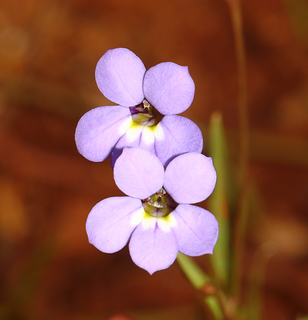
Grevillea wickhamii is an erect shrub or small tree to 6 metres in height which is endemic to Western Australia, Northern Territory and Queensland. It has grey-green leaves which have a holly-like shape.

Ipomoea costata, commonly known as rock morning glory, is an Australian native plant. It is found in northern Australia, from Western Australia, through the Northern Territory, to Queensland. Its tubers provide a form of bush tucker to some Aboriginal peoples, known as bush potato, or, karnti.
Cissus adnata is a woody vine species in the genus Cissus found in Asia and Australia.
Lambertia fairallii, commonly known as Fairall's honeysuckle, is a shrub which is endemic to the south-west of Western Australia.

Lobelia douglasiana is a flowering plant in the family Campanulaceae and is endemic to the Kimberley region of Western Australia. It is a small, spreading herb with blue and white flowers.

Hakea neospathulata is a flowering plant in the family Proteaceae and is endemic to Western Australia. It is a small, dense shrub with clusters of red flowers.
Grevillea hortiorum is a species of plant in the protea family that is endemic to Australia.
Grevillea pieroniae is a species of plant in the protea family that is endemic to Australia.
Wurmbea calcicola, also known as Naturaliste Nancy, is a species of plant in the Colchicaceae family that is endemic to Australia. It is classified as Endangered under Australia’s EPBC Act.
Wurmbea sinora is a species of plant in the Colchicaceae family that is endemic to Australia.
Wurmbea inframediana is a species of plant in the Colchicaceae family that is endemic to Australia.
Wurmbea dilatata is a species of plant in the Colchicaceae family that is endemic to Australia.
Wurmbea cernua is a species of plant in the Colchicaceae family that is endemic to Australia.
Wurmbea deserticola is a species of plant in the Colchicaceae family that is endemic to Australia.
Wurmbea inflata is a species of plant in the Colchicaceae family that is endemic to Australia. The specific epithet inflata (‘bladdery’) refers to the enlarged fruits.
Wurmbea saccata is a species of plant in the Colchicaceae family that is endemic to Australia.
Wurmbea pygmaea is a species of plant in the Colchicaceae family that is endemic to Australia.

Westringia capitonia is a species of plant in the mint family that is endemic to Western Australia.

Ornduffia calthifolia is a species of plant in the Menyanthaceae family of wetland plants that is endemic to Western Australia.

Ornduffia parnassifolia is a species of plant in the Menyanthaceae family of wetland plants that is endemic to Western Australia.






